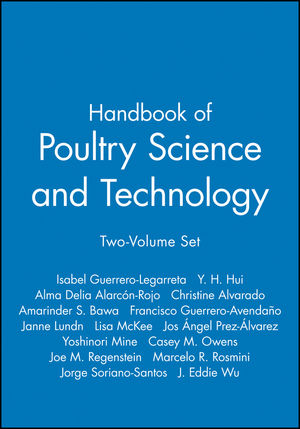Handbook of Poultry Science and Technology, Volumes 1 - 2, SetISBN: 978-0-470-18537-7
Hardcover
1484 pages
February 2010
 |
||||||
PART 1: POULTRY BIOLOGY TO PRE-MORTEM STATUS.
1. Poultry classification/biology.
2. Competitive exclusion.
3. Pre mortem handling.
4. Transportation.
PART 2:SLAUGHTER/CUTTING.
5. The slaughterhouse: building.
6. Slaughtering equipment.
7. Carcass evaluation and cutting.
8. Official control.
9. Packaging.
10. Kosher slaughter.
11. Halal slaughter.
PART 3: PRESERVATION: FREEZING.
12. Biochemical changes.
13. Physicochemical changes.
14. Low temperature storage.
15. Engineer. principles of freezing.
16. Quality of frozen poultry Sendra.
17. Quality of refrigerated poultry.
18. Refrigeration: equipment.
19. Freezing: equipment.
20. Refri./freezing retails.
21. Refri./freezing industr. Facilities.
PART 4 PRESERVATION: HEATING.
22. Heating, drying, chemicals.
23. Irradiation.
PART 5: COMPOSITION, CHEMISTRY, AND SENSORY.
24. Quality characteristics.
25. Chemical composition.
26. Texture and tenderness.
27. PSE.
PART 6: EGGS.
28. Eggs attributes.
29. Eggs Science and Technology.
PART 7: SANITATION AND SAFETY.
Section 1: Sanitation, regulations and disease outbreaks.
30. Chemical residues.
31. Microbiology of fresh poultry meat.
32. Principles of HACCP Wendakeen.
33. HACCP in poultry slaughterhouses.
34. Online-inspection.
35. Poultry/foodborne diseas. in US.
36. Poultry foodborne diseasess in Central and South America.
SECTION 5: WORKERS SAFETYY.
37. OSHA: basic considerations.
38. Etools.
VOLUME 2.
PART 1: SECONDARY PROCESSING.
1. Secondary processing.
PART 2: METHODS IN PROCESSING.
2. Emulsions: Principles.
3. Emulsions: Applications.
4. Breading: Principles.
5. Breading: Frying and freezing.
6. Mechan. deboning: Principles.
7. Mechan. deboning: Applications.
8. Marination: Principles.
9. Marination: Applications.
10. Non-meat ingredients.
PART 3: PRODUCT MANUFACTURING.
11. An overview on processed meat.
12. Canned poultry meat.
13. Turkey bacon.
14. Turkey sausages.
15. Breaded product (nuggets).
16. Paste product (paté).
17. Poultry ham.
18. Luncheon meat.
19. Eggs in processed products.
20. Special dietary products.
PART 4: PRODUCT QUALITY.
21. Sensory attributes.
22. Texture and tenderness.
23. Protein and poultry meat quality.
24. Flavors.
25. Color.
26. Refrigerated poultry handling.
PART 5: ENGINEERING PRINCIPLES.
27. Basic operations and conditions.
28. Processing equipment.
29. Thermal processing.
30. Packaging.
PART 6: CONTAMINANTS.
31. Contamination.
32. Microbial ecology and spoilage.
33. Campylobacter.
34. Microbiology: ready-to-eat.
35. Chemical analysis.
36. Microbial analysis.
PART 7: U.S. SAFETY SYSTEMS.
37. Sanitation requirements in US.
38. Principles of HACCP.
39. Enforcement tools in US.



